The carcass composition concerning their DM, CP, and EE contents are increased by age advance, but the ash percentages decreas. At the end of the experiment (16 weeks), DM did not significantly (P≥0.05) influence by all dietary treatments; yet, 0.01 per cent of the diet of either the 1st two substances was responsable for the highest CP and ash percentages and the lowest EE and energy contents. Moreover, 0.5 per cent of the diet of the 3rd substance gave the highest (P≤0.05) level among its tested levels concerning CP and the lowest (P≤0.05) EE and energy contents, but ash was not affected (P≥0.05). The best treatment (highest carcass crude protein and lowest ether extract percentages) was feeding fish the diet containing Diamond V-Original XPC at 0.5 per cent of the diet. The same probiotic at the same level led also to improve most of the histometric characteristics of the dorsal muscles. So, it could recommend the dietary inclusion of the probiotic Diamond V-Original XPC at 0.5 per cent of the tilapia diet.
Introduction
The first probiotics tested in fish were commercial preparations devised for land animals. Though some effects were observed with such preparations, the survival of these bacteria was uncertain in aquatic environment. Most attempts to propose probiotics have been undertaken by isolating and selecting strains from aquatic environment. These microbes were Vibrionaceae, pseudomonads, lactic acid bacteria, Bacillus spp. and yeasts. The most promising prospects are sketched out, but considerable efforts of research will be necessary to develop the applications to aquaculture (Gatesoupe, 1999). Aquaculture is one of the fastest developing growth sectors in the world. However, disease outbreaks are constraint to aquaculture production, thereby affects both economic development of the country and socio-economic status of the local people in many countries. Disease control in aquaculture industry has been achieved by following different methods using traditional ways, synthetic chemicals and antibiotics. However, the use of such expensive chemotherapeutants for controlling diseases has been widely criticized for their negative impacts like accumulation of residues, development of drug resistance, immunosuppressants and reduced consumer preference for aqua products treated with antibiotics and traditional methods are ineffective against controlling new diseases in large aquaculture systems. Therefore, alternative methods need to be developed to maintain a healthy microbial environment in the aquaculture systems there by to maintain the health of the cultured organisms. Use of probiotics is one of such method that is gaining importance in controlling potential pathogens (Sahu et al., 2008). Therefore, the present research aimed to study the effect of dietary graded levels of three pre-and probiotics on Nile tilapia quality (chemical composition and muscular histometry).
Materials and Methods
The experimental period was 16 weeks after two weeks adaptation period. All the experimental conditions, diets, and facilities were as mentioned before in Abdelhamid et al. (2013a). The 1st and 2nd additives used were the prebiotic Aqua Superzyme and the probiotic Garlen Allicin, each at 0.01, 0.02, and 0.03 per cent of the diet. The 3rd additive used was the probiotic Diamond V-Original XPC at 0.4, 0.5, and 0.6 per cent of the diet, besides the control without additives.
Chemical analysis of fish:
At the end of experimental period, three fish/treatment were taken for body composition analysis. The whole-fish body from the beginning and the end of the experiment were analyzed in triplicates. Fish samples were weighed and killed. To obtain a homogenous material for chemical analysis, fish carcass of each group was homogenized by a mixer and stored at -20oC until analysis. Samples of the homogenized fish carcass materials were taken for determination of dry matter. Chemical analysis of fish carcass was carried out according to the methods described by A.O.A.C. (1990) for dry matter, crude protein, ether extract, and ash. Nitrogen free extract (carbohydrate) content was calculated by subtraction the total percentages of CP, EE, CF and ash from 100. The gross energy contents of the fish samples were calculated by using factors of 5.65, 9.45 and 4.2 Kcal/g of protein, lipid and carbohydrate, respectively (NRC, 1993).
Histological examination:
At the end of the experiment, fish were sacrificed and dorsal muscles were sampled. Samples were fixed in 10 per cent neutralized formalin solution followed by washing with tab water, then dehydrated by different grades of alcohol (70, 85, 96 and 99 per cent). Samples were cleared by xylene and embedded in paraffin wax. The wax blocks were sectioned to six micron. The sections were stained by hematoxyline (H) and eosin (E) (Roberts, 2001), and then subjected to a histometric examination for dorsal muscles according to Radu-Rusu et al. (2009).
Statistical analysis:
Data obtained were analyzed using one-way analysis of variance which was performed according to SAS (2006). Differences were subjected to Duncan’s (1955) multible range test.
Results and Discussion
Carcass composition:
Data of chemical composition ( per cent DM basis) of fish body at the start and at the end of the experimental period are shown in Tables 1-3 for those fed the Aqua Superzyme containing experimental diets, the Garlen Allicin probiotic containing experimental diets, and the Diamond V (Original XPC) probiotic containing experimental diets, respectively, concerning their dry matter (DM), crude protein (CP), ether extract (EE), and ash besides the energy content (GE).
The carcass composition concerning their DM, CP, and EE contents are increased by age advance, but the ash percentages decreas. At the end of the experiment, DM did not significantly (P≥0.05) influence by all dietary treatments; yet, A1 and G1 were responsable for the highest CP and ash percentages and the lowest EE and energy contents. Moreover, XPC2 gave the highest (P≤0.05) level among its tested levels concerning CP and the lowest (P≤0.05) EE and energy contents, but ash was not affected (P≥0.05) as shon from Tables 1, 2 and 3, respectively. Table 4 shows that the best treatment (highest carcass crude protein and lowest ether extract percentages) was (3*2, XPC2) by feeding fish the diet containing Diamond V-Original XPC at 0.5 per cent of the diet.
El-Hadidy et al. (1993) studied die effect of experimental diets namely, brewers tefla, activated sludge, yeast and algae as maior contituents of Nile tilapia diets. Statistical analysis indicated that no significant differences were found in crude protein, lipids, ash, dry matter of the body as affected by experimental diets, except fish fed the sludge diet.
Noh et al. (1994) fed Isralli carp of 300 g body weight on basal diet composed of fish meal 9 per cent soybean meal 47 per cent wheat flour 36.05 maize gluten 3.6 per cent and sardine oil 2 per cent plus vitamins minerals supplements or that diet plus oxytetracyline 0.05 per cent Nosiheptide, 0.1 per cent Lactobacillus concentrate (Strepococcus faccium cencell 68), yeast culture (yeast culture on grain media) 0.5 per cent or enzyme complex (alpha- amylase, beta glucanae, fluranase, pectinase endoprotease, exoprotease and cellulase) 0.05 per cent. Increases in the body content of crude fat, crude fiber and niteogen free extract were detected in case of treated groups.
Table 1: Carcass chemical composition ( per cent DM basis) and gross energy content (cal./100g) of Nile tilapia (O. niloticus) fed the Aqua Superzyme experimental diets.
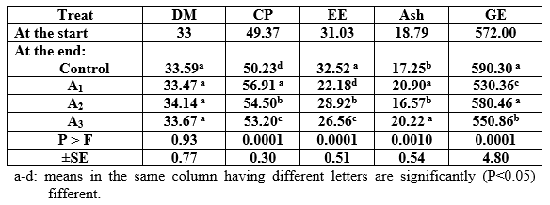
Kobeisy and Hussein (1995) used Oreochromisniloticus to determine the effect of three concentrations of live yeast (5,10 or 20 per cent of dietary DM) on body composition. The protein content of the fish body was significantly higher in fish fed diets containing yeast than in those fed control diets. Also, Adamek et al. (1996) found that the addition of the probiotic Ascogen at 0.62 and 2.5g/kg pelleted diet lo rainbow trout resulted in 11.2 and 12.1 per cent in protein content of fish flesh, but reduced fat content of fish flesh by 42.9 and 45.8 per cent, respectively compared with the basal diet given alone. Aseogen at 5g/kg diet had no positive effect on those values. Moreover, Khattab et al. (2004) and El-Haroun (2007) reported that dietary inclusion of Biogen® significantlly increased crude protein content and decreased total lipids in whole fish body of Nile tilapia and African catfish, respectively.
Table 2 : Carcass chemical composition ( per cent DM basis) and energy content (cal/100g) of Nile tilapia (O. niloticus) fed the Garlen Allicin experimental diets.
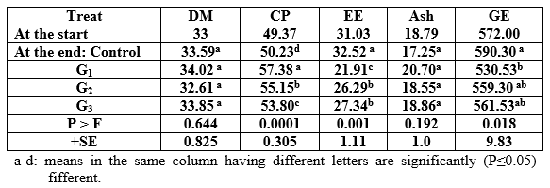
Table 3: Carcass chemical composition ( per cent DM basis)and energy content (cal/100g) of Nile tilapia (O. niloticus) fed the Diamond V (Original XPC) experimental diets.
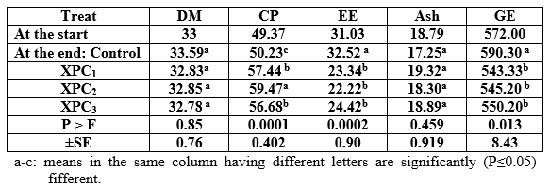
In an evaluation for the effects of graded levels of a new commercial probiotic Hydroyeast Aquaculture® (0, 5, 10 and 15 g/Kg diet) on both sexes of adult Nile tilapia Oreochromisniloticus, on their carcass composition for 8 weeks, the obtained results showed that tested probiotic at level of 15 g /kg diet and 10 g /kg diet for adult males and females O.niloticus, respectively, realized slight improving of fish carcass composition. Hence, it could be concluded that Hydroyeast Aquaculture® probiotic is useful at levels of 15 g /kg diet and 10 g /kg diet for enhancing production performance of adult males and females Nile tilapia (O. niloticus) respectively, so may be using of this probiotic led to economic efficiency especially, for fish farming and hatcheries (Khalil et al., 2013).
Table 4: Comparison between carcass chemical composition and energy content of Nile tilapia (O. niloticus) fed the Aqua Superzyme, Garlen Allicin, and Diamond V (Original XPC) experimental diets, at the end of experiment.
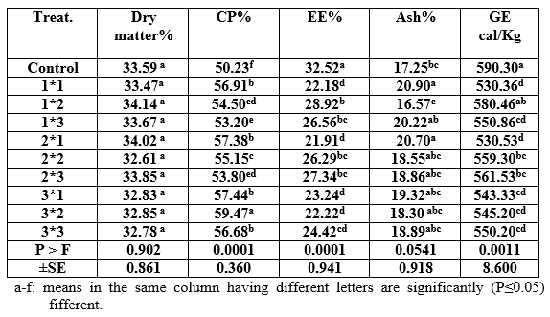
A negative relationship was noticed between CP and EE contents of fish body but a position relationship between CP and ash contents was recorded too (Abdelhamid et al., 2005 and 2007; and El-Ebiary and Zaki, 2003). Yet, El-Saidy et al. (1999) and El-Saidy and Gaber (2002) found that there was a positive correlation between crude protein and fat contents of the fish.
Histometric characteristics of dorsal muscles:
The following Tables 5-8 and Figures 1-3 present data of the histometric characteristics carried out on the dorsal muscles of experimental fish fed diets containing the pre-and probiotics Aqua Superzyme (A) prebiotic, Garlen Allicin (G), and Diamond V (Original XPC), respectively. All histomestic parameters were improved by the dietary inclusion of either pre-or probiotics. Yet, the best treatment realized improvement of these histometric characteristics of fish dorsal muscles compared with the control or other treatments was 3*2, i.e. the diet containing Diamond V (Original XPC) at 0.5 per cent of the diet (Table 8).
The results revealed that fish fed the high level of A prebiotic (A3) followed by A1 led to significantly (P≤0.05) increased the largest diameter (µm), smallest diameter (µm), mean diameter (µm), smallest/largest ratio and the percentage of muscular bundles area/mm2 of dorsal muscles compared with the A2 and control treatments, meanwhile, the intensity of muscular bundles/mm2 significantly (P≤0.05) decreased in fish fed the A prebiotic compared with the control group. On the other hand, there was unclear trend in the percentage of interstitial connective tissue/mm2 among all treatments (Table 5).
Also, Nile tilapia fed G probiotic significantly (P≤0.05) increased the largest diameter (µm), smallest diameter (µm), mean diameter (µm), smallest/largest ratio and the percentage of muscular bundles area/mm2 of dorsal muscles compared with the control; however, the intensity of muscular bundles/mm2 significantly (P≤0.05) decreased in fish fed the G compared with the control group. On the other hand, there was unclear trend in the percentage of interstitial connective tissue/mm2 among all treatments (Table 6).
In addition, fish fed Diamond V (Original XPC) probiotic revealed significantly (P≤0.05) increases in the largest diameter (µm), smallest diameter (µm), mean diameter (µm), and the percentage of muscular bundles area/mm2 of dorsal muscles compared with the control treatment, meanwhile, the intensity of muscular bundles/mm2 significantly (P≤0.05) decreased in fish fed the XPC prebiotic compared with the control group. On the other hand, there was unclear trend in smallest/largest ratio and the percentage of interstitial connective tissue/mm2 among all treatments (Table 7).
Generally, it can be noted that dietary supplementation of experimental commercial pre- (A) and (G and XPC) probiotics led to improvement of the histometric characteristics of the dorsal muscles of fish compared with the control group, which fed the basal diet free from pre- or probiotics. These improvemrnts in the histometric parameters are positively corelated with the obtained results of different parameters concerning the growth performance, feed and nutrients utilization, difestibility, immunity, carcass composition, haematology, and economic evaluation. Also, these improvements are due to the contents of the tested pre-and probiotics, including: minerals, enzymes, amino acids, and benificial microorganisms (Abdelhamid et al., 2013a, b, and c).
Table 5: Histometric characteristics of dorsal muscles of mono-sex of Nile tilapia (O. niloticus) fed the Aqua Superzyme prebiotics of the experimental diets.
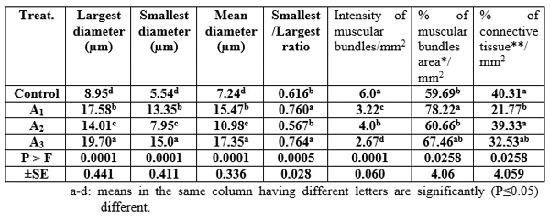
Mean in the same column with different small superscripts letters are significantly (P?0.05) different.
* per cent of muscular bundles area / mm2 = ([3.14 X (mean diameter/2)2] X Intensity of muscular bundles/mm2) X 100, whereas: the muscular bundles were considered in approximately circular shape.
** per cent of connective tissue / mm2 = (1- muscular bundles area, mm2) X 100.
In this topic, the present findings are closed agree with those reported by Abdelhamid et al. (2004), they found that the O. niloticus group fed diet containing 1 kg Betafin® / ton and 600 ml Biopolym® / ton was the best treatment among all treatments concerning the muscular bundles and total surface area occupied by the muscular bundles/mm2 mm2 (least thickness of connective tissues between muscular bundles and thickness of skin and subcutaneous layer), and net return. Also, they added that the superiority of the histological structure of dorsal muscles in this treatment among all treatments was related with the high growth performance, feed and nutrients utilization and characteristics of fish production.
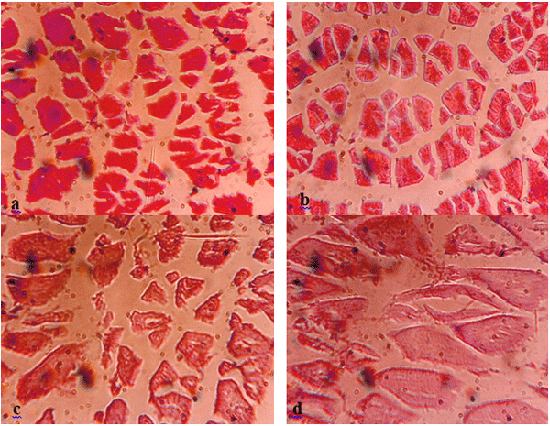
Moreover, Khalil et al. (2009) revealed that mono-sex O. niloticus fed diet containing 25 per cent replacement of fish meal by supplemented jojoba meal Simmondsia chinensis with methionine and Biogen® at level of 0.6 and 2.0 g/kg diet respectively (T2), led to significantly (P ≤ 0.05) improved the histometric characteristics of the dorsal muscles of mono-sex O. niloticus compared with the control treatment (T1).
Table 6: Histometric characteristics of dorsal muscles of mono-sex of Nile tilapia (O. niloticus) fed the Garlen Allicin probiotics of the experimental diets.
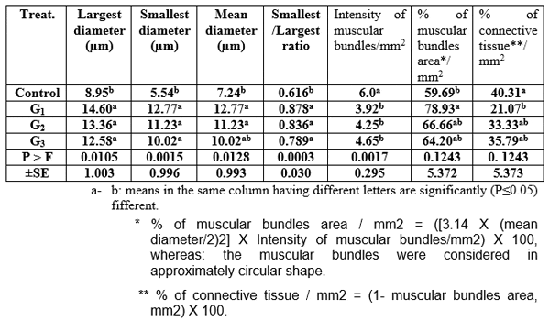
Table 7: Histomitrac characteristics of dorsal muscles of mono-sex Nile tilapia (O. niloticus) fed the Diamond V (Original XPC) probiotics of the experimental diets.
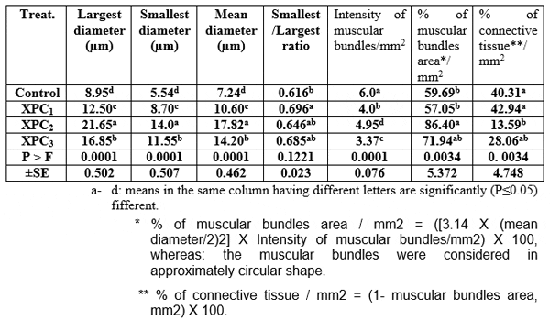
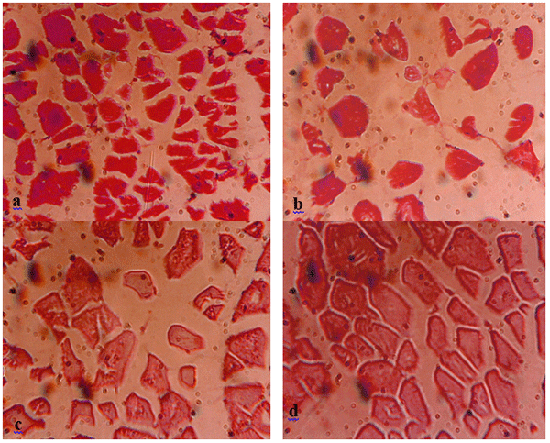
Also, Mehrim (2009) reported that mono-sex O. niloticus fed basal diet supplemented with 3g Biogen® Kg-1 diet for 14 weeks significantly (P ≤ 0.05) improved histometric parameters of fish dorsal muscles among other treatments. In addition, Abdelhamid et al. (2009) found that African catfish fed diet containing 1 g T-Protphyt 2000 (a new patent local probiotic) / kg diet led to improvement of most histometric characteristics of the fish dorsal muscles compared with the control and other treatments.
Table 8: Comparison Histomitrac characteristics of dorsal muscles of mono-sex Nile Tilapia (O. niloticus) fed the Aqua Superzyme, Garlen Allicin, and Diamond V (Original XPC) of the experimental diets.
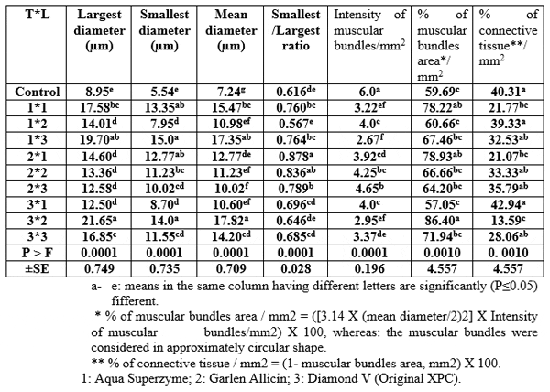
Also, Abdelhamid et al. (2009) showed that the diet containing 1 g/Kg probiotic reflected the best growth and feed utilization parameters. Increasing the probiotic level increased fish carcass protein, fat and energy contents, as well as RBCs, WBCs, and platelets.The same treatment led to improvement of most histometric characteristics of the dorsal muscles of African catfish compared with the control and other treatments. The results showed also positive effect of the probiotic at the two concentrations (120 & 240 mg) against all the tested bacteria (Aeromonas hydrophilla, Pseudomonas aeruginose, Pseudomonas fluorescent, Vibrio.sp, Klebsiella sp, Shigella sp, Salmonella sp, Proteus sp, and Escherichia coli).
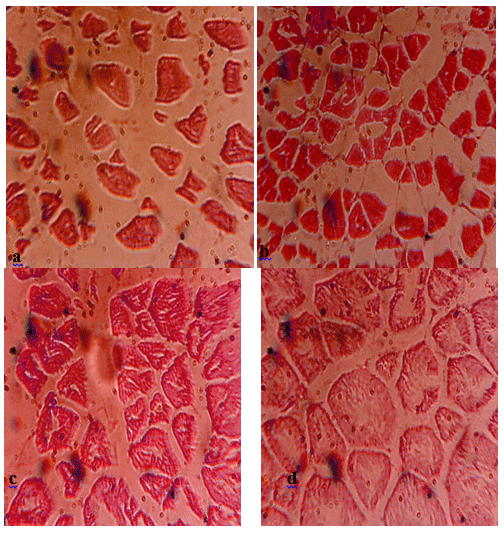
March 2014




